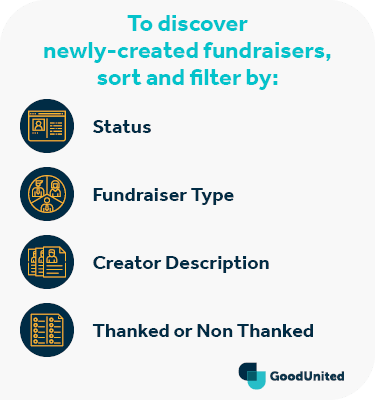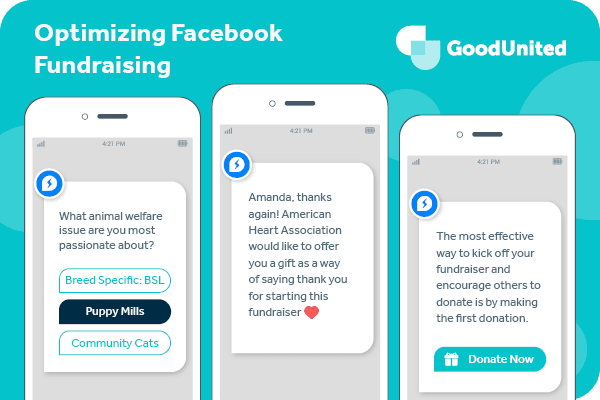Guest post by Nick Black, Founder and CEO of GoodUnited
Even as nonprofit supporters flock to Facebook to donate to their friends and family members’ fundraisers, create their own fundraisers, and share their peer-to-peer event participation far and wide, few nonprofits are actually engaging with those supporters on a meaningful level.
Looking forward to fundraising in 2021 and beyond, your nonprofit’s supporters are going to continue engaging through Facebook. This entirely virtual platform has become even more popular throughout the COVID-19 pandemic and will continue to play a crucial role in fundraising in the future.
At GoodUnited, we help nonprofits elevate their virtual fundraising efforts on Facebook with an emphasis on understanding, inspiring, and cultivating relationships with supporters on the platform. We’re going to walk through how you can raise your relationships with the next generation of social supporters and secure recurring support for life through the following points:
-
Why should you focus your attention on Facebook supporters?
-
3 Strategies to Turn Facebook Supporters into Recurring Supporters
Before we discuss strategies to develop recurring support on Facebook, let’s first discuss why you should place such a focus on social fundraising— especially since many would suggest otherwise.
Why should you focus your attention on Facebook supporters?
If you Google “Facebook Fundraising,” you’ll find the following:
-
Branded pages on Facebook itself containing instructions about how to start fundraisers.
-
Opinion pieces about how nonprofits shouldn’t prioritize Facebook fundraising in their strategy.
Let’s start by countering the second point— that your nonprofit shouldn’t prioritize Facebook fundraising. There are a few different arguments posited, whether that this fundraising channel can’t result in noticeable revenue or that it’s impersonal and an ineffective way to connect with supporters on a meaningful level.
These arguments couldn’t be further from the truth. Not only is giving through social media on the up and up (with a measured 11% increase in just one year), but individual nonprofits— such as the American Cancer Society, St. Jude Children’s Hospital, and others— have raised immensely impactful and mission-driving funds through the platform.
The arguments in support of opting into Facebook fundraising go well beyond an increase in revenue, however. For example:
-
Your nonprofit’s Facebook audience is likely a new, untapped audience segment. In fact, through our work at GoodUnited, we’ve seen that up to 90% of the Facebook users who our nonprofit partners interact with on the platform are new to the organization’s cause.
-
Social fundraising technology has evolved and now allows you to discover new fundraising campaigns and engage with the users that start those campaigns one-on-one. We’ll dive into this in more detail later in this piece, but you can actually message each individual fundraiser personally to continue cultivating relationships.
And last but certainly not least? Users are going to conduct Facebook fundraisers on your behalf, whether or not you’ve chosen to optimize your efforts on the platform.
Facebook fundraisers are user-led, meaning supporters can start campaigns on behalf of any nonprofit that’s a verified organization on the platform. Even if you haven’t registered for Facebook Payments, the donation will be processed by Network for Good and find its way to your nonprofit.
So, the choices then become:
-
Step into the growing wave of social fundraising, which provides an expansive audience and endless opportunities to build new relationships with supporters.
-
Ignore users that start fundraisers on your behalf, leaving them feeling underappreciated and with a bad taste for fundraising on behalf of your organization.
Choosing not to pursue connections with Facebook supporters is simply wasting an opportunity to cultivate relationships that last. So, let’s dive into three strategies to raise your relationships with supporters on Facebook to not only secure recurring donations, but champions of your cause for the long run.
3 Strategies to Turn Facebook Supporters into Recurring Supporters
Even before the COVID-19 pandemic was anywhere near its peak, studies found that the number of volunteers and donors has been declining over the past decade. When there are fewer supporters engaging with your organization, it’s more crucial than ever to retain each individual supporter and grow that relationship over time.
According to the retention experts at Qgiv, thanking supporters and continuing to engage with them after campaigns end are essential strategies to increase retention. So, let’s walk through three strategies that you can use to do exactly that on Facebook.
Acknowledge Every Supporter

The first step to retaining Facebook supporters is giving users who start fundraisers the recognition they deserve. Unfortunately, Facebook doesn’t notify your organization when a user starts a fundraiser on your behalf— only when that campaign raises $50+. This just means you’ll need to take initiative to find this information using Facebook’s Sort & Filter tool.
Navigate to the “Fundraisers” view of your nonprofit’s Facebook page. From that view, organize all of the fundraisers started on behalf of your nonprofit in the following manner:
-
Sort to show the fundraisers that are most recently started.
-
Filter to show fundraising campaigns that your nonprofit hasn’t acknowledged and thanked yet.
From there, you’ll want to personally thank each and every user who started a fundraiser. We recommend posting a personalized thank-you note on the campaign wall of each one.
Bonus! Thanking the users who donate to these fundraisers is a trickier task, as Facebook’s privacy policies limit the information you can receive. The GoodUnited team wrote a comprehensive guide to thanking Facebook donors to help you get started, including templates that you can use when reaching out to these supporters.
Leverage Facebook Groups
Facebook groups can be used not only to thank your supporters but also to increase their engagement with your organization. This is because groups present two unique benefits for interactions with your nonprofit:
They’re favored in Facebook’s algorithm, meaning your nonprofit’s supporters are more likely to see a post made by your nonprofit in a group than one made on your core Facebook page.
-
They’re the perfect conduit to build community between Facebook supporters, whether users who start fundraisers or those participating in a larger peer-to-peer event, both during the campaigns themselves and long after they’re completed.
We recommend creating Facebook groups corresponding to segments of your nonprofit’s Facebook supporters, such as those who start Facebook birthday fundraisers, those participating in a virtual peer-to-peer campaign, and even those who act as strong ambassadors for your organization on the platform.
When you create these groups, there are a couple of best practices you can adhere to in order to make the most of them, including:
-
Create communities for virtual fundraising event participants to connect. Let’s say you’re hosting a virtual walk-a-thon, with participants each walking 10k steps each day for a month. These participants can check in with one another, share their training regimes and successes, and share encouragement by donating to other participants’ fundraisers. You can even live stream a workout within the group and accept donations using Facebook’s Live Donate tools.
-
Connect with supporters year-round. Groups don’t end simply because a fundraising campaign does. Building off of the virtual walk-a-thon example, you can continue engaging those participants long after the fundraiser is completed by checking in regularly, sending information about the impact of their efforts, and explaining how they can participate in the event again in the following year.
With Facebook groups, you can replicate the camaraderie of in-person fundraising fully online and build stronger connections between your Facebook supporters and your cause.
Connect Through Facebook Messenger
Last but certainly not least, use Facebook Messenger to cultivate lasting relationships with your Facebook supporters.
Traditionally, the guidance around social fundraising has been to acquire as much information as possible about your supporters on social media, store that information in your constituent relationship management system, and use it to connect with social media users on other platforms— email, direct mail, targeted advertisements, and more.
We’ve found that connecting with social supporters in-channel is a much more effective strategy— after all, this keeps engagement on the platform through which the supporter originally sought you out. In fact, we’ve found that there is a 94% open rate of messages sent to nonprofit supporters through Messenger (compared to the <15% open rate of emails).
Invite your Facebook supporters to connect with your nonprofit via Messenger. Then, you can share information such as:
-
Tips to help them reach their Facebook fundraising goals.
-
Educational resources about your nonprofit and your mission.
-
Encouragement during fundraising campaigns.
-
Answers to any questions they may have about your nonprofit and mission.
-
Surveys and one-off questions to better understand why they support your organization and how they prefer to engage with your mission going forward.
Here’s an example of what Messenger communications could look like, pulled from this guide to Facebook fundraisers:

With Messenger, you can continue communicating one-on-one with Facebook supporters throughout the year. You can build a relationship with each individual supporter in-channel and inspire them to engage and give to your organization again and again.
Wrapping Up
With these strategies, it’s true that you’ll be able to build relationships that last with your Facebook supporters and inspire them into recurring engagement with your cause.
However, it’s also true that these strategies can be a huge administrative lift for organizations with limited time and human resources to dedicate to Facebook itself. If that’s you, we recommend partnering with a company that provides social fundraising solutions for Facebook.
A partner well-versed in social fundraising can tackle some of the technical challenges of thanking and stewarding each individual fundraiser, so you can focus on what really matters— advancing your nonprofit’s mission.

About Nick Black
Nick is the Founder and CEO of GoodUnited, a venture backed Software as a Service (SaaS) startup that helps nonprofits like Wounded Warrior Project, American Cancer Society, World Wildlife Fund create 1:1 relationships with their donors through the combination of data science and human judgement delivered in conversational messaging platforms. Nick’s work with GoodUnited resulted in being named The University of North Carolina at Chapel Hill’s 2017 Distinguished Young Alumnus.
Nick has been an innovator and leader at the intersection of business and social impact for over ten years. The concept for GoodUnited came through Nick’s work co-founding and leading Stop Soldier Suicide, a 501c3 that grew from startup to national leader in reducing veteran suicide to the national average in ten years. Stop Soldier Suicide’s growth and impact resulted in Nick being selected as a Presidential Leadership Scholar and a Leadership North Carolina Fellow.
Nick co-founded Stop Soldier Suicide stemming from his experiences leading Paratroopers as a Ranger qualified Army Officer with the 173rd Airborne during 27 months deployed to combat zones in Afghanistan. During Nick’s six years of service he was awarded two Bronze Stars, an Army Commendation Medal for Valor and as a Field Artillery Officer, was repeatedly ranked 1st among 50 peer Officers in a premier Infantry Battalion.
